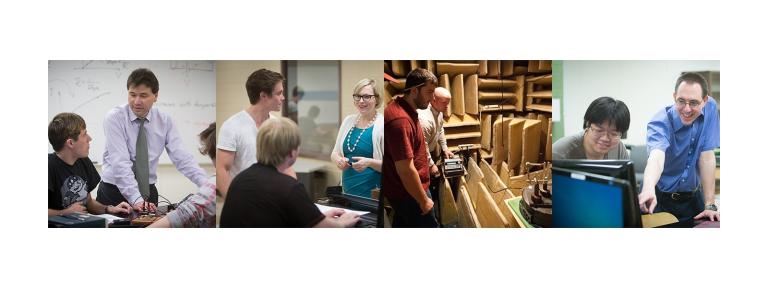
“Physicists can do everything engineers can. We are great problem-solvers who can adapt to changing technology and paradigms.”
Just 20 years after the Physics program launched at Kettering University, the department has already achieved remarkable accomplishments that distinguish it from any other program in the country.
Kettering has the only Applied Physics program in the world accredited by ABET, a nonprofit, non-governmental organization that accredits university applied science, computing, engineering and engineering technology programs. That, combined with the fact that all Kettering students gain more than two years of professional work experience during their co-op rotations, significantly differentiates Kettering’s program from others.
“Many physics programs are designed to prepare students to go off to grad school to pursue a Master’s or Ph.D.,” said Dr. Kathryn Svinarich, Physics department head. “We do have students who choose that route, but we also have about half of our graduates who go straight into the workforce. That’s rare in Physics. Other physics programs are looking at Kettering as a model now because of co-op and because we are the only ABET-accredited program.”
In its 20-year history, Kettering Physics graduates have gone on to impressive careers in industries as varied as acoustics, optics, finance, automotive, research and development, medicine, and sports equipment design for organizations like NASA, Apple, Argonne National Laboratory, Harley-Davidson and Easton Sports to name a few. The rigor of the program, along with the flexibility a Physics degree offers graduates an abundance of career options.
“The co-op program allows students to immediately apply what they learn,” Svinarich said. “Students come to Kettering because we can find them jobs with a physics flavor but that doesn’t mean your business card is going to say ‘physics’ -- it’s often going to say ‘engineer.’ Physicists can do everything engineers can. We are great problem-solvers who can adapt to changing technology and paradigms.”
Another unique aspect of Kettering’s Physics program is the makeup of the department itself. A third of the faculty (including the department head) in the department are female -- impressive considering underrepresentation of women in Science, Technology, Engineering and Mathematics is an ongoing issue worldwide. According to the Committee on the Status of Women in Physics, in the U.S. only 15 percent of faculty positions are held by women. Only about 20 percent of Physics Ph.Ds in Physics are female.
“The presence of female faculty, and more importantly, the mentoring role they play for students strongly correlates with an increased number of female students,” Svinarich said. “Women and men in this department understand that every individual is different, and we collectively work very hard to support each other’s strengths and weaknesses. What results is a very rich and dynamic team."
The department’s mix of faculty who are committed to both teaching and research is also a major factor in the success of the Physics program.
“The commitment to teaching, hands down, really stands out,” Svinarich said. “These people are at Kettering because they want to work with undergrads. Research with undergraduates is labor-intensive because they’re less experienced than graduate students. You have to be there to mentor them every step of the way. Our faculty are really committed to teaching and mentoring undergrads, and that makes a positive impact on our students. There is a strong sense of community in the Department of Physics; we care about each other and about our students.”
Several Physics faculty are engaged in applied research that is aimed at making positive impacts on humanity. Dr.Uma Ramabadran and Dr. Gillian Ryan are working on research to improve technology in non-electric incubating blankets that can be used to reduce infant mortality rates in areas that lack electricity. Drs. Prem Vaishnava and Ron Tackett are working on an alternative treatment for ocular cancer and Dr. Ronald Kumon has worked to develop new ways to detect cancer. Dr. Corneliu Rablau does research on photonics and fiber optics with impact on both industrial and biomedical applications. All of these projects involve undergraduate students.
“Our faculty are great at collaborating and working within a group,” Svinarich said. “They pull other collaborators in from other academic departments, other universities and private companies. They’re not only doing research for their own careers and benefit, they are giving our student researchers opportunities to get that experience in a lab as undergrads. We all want to be the best at what we do and take pride in the work we do as a department.”
The Department of Physics has several activities planned to celebrate its 20th anniversary during Kettering University’s Homecoming weekend May 15-17. On Friday, May 15, Rablau will be presenting a special lecture entitled, “Light Beyond the Bulb: Why Light and Photonics Matter,” from 10-11:30 a.m. in the Photonics and Fiber Optics Lab (. All of the Physics labs will be open in the Academic Building from 2-4 p.m., with giveaways including diffraction glasses and whistles with LED lights for visitors. A number of Physics faculty and students will also be present on Saturday morning to showcase their research in the university-wide poster session, hosted in the Campus Center, which will also host the special Light Beyond the Bulb exhibition of banners highlighting major light-based technologies, in celebration of the International Year of Light.
“The sheer number of Physics graduates we now graduate each year puts us in the top 10 percent of undergraduate-only Physics departments,” Svinarich said. “We welcome everyone to visit the Physics Department during Homecoming.”